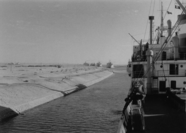Evasion
As turnout , turnout or short crossover refers to a two-lane point on an otherwise single-lane traffic route.
Streets
On narrow roads or driveways , widened areas serve as evasions where the terrain allows. However, they are sometimes created specifically for this purpose.
Lanes
On single-track railway lines , the crossings and passing points are train stations . If there are no access points for travelers in train stations, i.e. there are no traffic stops there , the operating points concerned are often referred to as crossroads or operating stations (Bbf). Even with single-track tram routes, attempts are being made to connect the intersections with stops . If two trains carrying passengers are to cross at an intersection without passenger access, an operating stop is required for at least one of the two.
A passing or crossing track usually has two operational functions:
- allows the crossing of trains
- it allows the reconditioning of a slower by a faster train
Dodges are used in right-hand or left-hand traffic , depending on the local situation . The driving regulations in the area of the siding do not always correspond to the general driving regulations in the country concerned. If the same track is always used in the respective direction , so-called fallback switches are often used, so that the two switches of a switch never have to be set.
Special forms
- the alternative junction makes it possible to include a service trip in the meantime and to release the track again. The blocking time required for connection operation is thereby greatly reduced.
- the Abt switch is a special construction for funicular railways and, as a special feature, does not have any moving parts
- the double-track island is an elongated turnout in the form of a double-track section of an otherwise single-track line that can be several kilometers long and enables two train journeys to meet without stopping. This is also called a flying intersection . Usually, such systems are not train stations that represent two operating points delimiting the double-track section, if they do not fulfill any additional functions, they are transfer points.
- the transfer terminal is located at the end of tram lines and is also used to meet two trains. The arriving train can only start the shunting process when the train that is still in the terminal has departed.
- In the so-called follow - up train operation, two trains run in one direction in quick succession through the crossing point, the oncoming train remains standing until both oncoming trains have crossed.
Waterways
There are alternative points on waterways where the fairway or the fairway is too narrow or not deep enough that two ships on the opposite course cannot pass safely. The fairway can be in a river , a canal or, in exceptional cases, in a natural strait . Alternative points are created to widen or deepen the fairway, in which one or more ships can "park" depending on their length. For example, there are several turnouts in the Kiel Canal . In addition, there are also waterways with separate bypass channels or ship switches in which a larger number of ships - that is, a convoy - can "park" while oncoming traffic passes elsewhere.
Passage with a stop at the Gmunden tram , although right-hand traffic applies in Austria, it is used in left-hand traffic
Feeder ships in the Kiel Canal in a passing point on waiting position
Ship switch in the course of the Suez Canal , 1957



